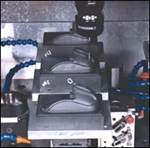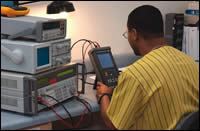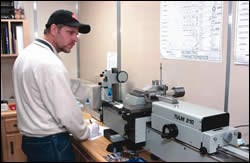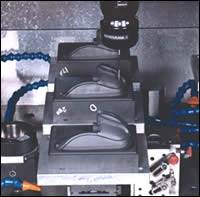Gage Calibration: When in Doubt Send It Out
A discussion on how gages get calibrated, who calibrates them and where it is performed.
Nothing lasts forever, and so it is with gage accuracy and repeatability. Drop them enough, subject them to the rigors of manufacturing plants, or mar their measuring surfaces from abrasive contact and sooner or later gages need to be re-calibrated. Most quality conscious machinists and inspectors will agree on this, but how gages get calibrated, who calibrates them and where it is performed is a subject worthy of discussion.
Aside from the obvious quality pitfalls of using gages that aren’t accurate, avoiding calibration can become very costly in other ways as well. For example, decreased productivity, or losing contracts due to lack of measuring compliance or certification are factors few can afford to risk in today’s extremely competitive environment.
Welcome! You’ve unlocked premium content.
With high stakes such as these, one might assume that proper resources, methods and budgets are commonly deployed for calibration programs. On the contrary, it is fairly typical for users to make the mistake of attempting to calibrate their own gages using the wrong methods and/or tools for perceived savings and convenience.
It’s Easy, Right?
Some people think calibrating is a quick and simple fix. They may grab a few gage blocks, perform a hasty inspection using crude measurement principles and assume they’re done. What they don’t take into account is record keeping, training, follow-up, maintenance of master standards, environment, official procedures and other issues that affect proper calibration. People are often misinformed on what tools and methods are acceptable for performing calibration.
In-house calibration—especially comprehensive, established programs in large companies that have thousands of gages—can be a very effective approach for the right application. However, outsourcing calibration is perhaps the most prudent method for many companies for a variety of reasons, among the most prominent being cost and competence.
Outsourcing Reduces Cost, Increases Reliability
If you are committed to proper calibration, outsourcing will save money and headaches. After you factor in the cost of hiring qualified technicians, buying sophisticated equipment, training and record keeping—all of which is essential to guarantee certifiable results—it is surely no small expense to do it yourself.
The break-even expenses have been estimated for those brave enough (or large-scale enough ) to attempt it in-house at well into the thousands. At a minimum, you’re talking around $250,000.00 for initial ramp up with equipment, depending on your application. Then, probably another $100,000.00 for a few technicians—and that’s not including other issues like taking up valuable manufacturing space to build a climate controlled lab. It is estimated that it would cost more than $75,000.00 annually to operate an in-house lab. In other words, unless you have a tremendous number of gages, it is cost-prohibitive to set up an in-house calibration operation.
Standard Problems, Quality Solutions
To illustrate how expensive it can be to calibrate your standard gage blocks in-house, consider that if you wanted to achieve a low level of uncertainty, such as +/- 2 or 3 millionths of an inch, this would require you to send a master set of blocks directly to N.I.S.T. The cost could be astronomical; up to $40,000.00 for a full set of inch and metric masters. The sensible alternative would be to send your blocks to an accredited laboratory that has already paid the expense to have their master blocks calibrated through N.I.S.T. The savings can be significant. Typical costs to calibrate gage blocks range from $2.00 to $ 5.00 per block for a commercial laboratory vs. $80.00 per block when calibrated by N.I.S.T.
Cost isn’t the only advantage when outsourcing. Other critical issues, such as standards, also come into view. Are you an A2LA 17025 accredited source? An appropriately accredited lab will ensure that you meet compliance with today’s standards. Consider also that today’s standard may change tomorrow. Keeping up with the continually changing requirements is difficult at best for those who aren’t plugged in and unfamiliar with the process.
Other obvious benefits are improved quality, reliability and convenience. It’s safe to conclude that if you are consistently using a dedicated, independent source, your quality will increase. Plus, larger companies benefit by standardizing their gage calibration and record keeping all within one source.
Who Will Do What?
Before you send those gages out, the best advice is to be careful. There are several options, based on your needs. Depending on the work required, you could send the gage back to the manufacturer or maybe to a lab. The problem with going back to the manufacturer is most of them don’t have comprehensive calibration and repair services, so they end up recommending you a new gage or maybe a discounted one, their motives being obvious. Check to see if they have an established repair and calibration program with thorough procedures.
Another problem with going to the manufacturer is multiple sourcing. If you have gages from different manufacturers like most people, it becomes difficult trying to send tools to various sources. Be sure they can handle all major brands of gages in one location.
Other risks are the type of lab. You may find a good house, perhaps even a specialist in certain product areas, but beware of size. It is not uncommon to see smaller one- or two-person outfits close up shop. Also, look for adequate equipment, experience and ability to service effectively. A good guideline for turnaround is a minimum of three and a maximum of 10 days.
Nothing’s Perfect
Of course there are a few downsides to outsourcing. When your gages leave the plant, you are without means to measure if you don’t have a backup plan. You also need to schedule accordingly or you’ll interrupt production. Although it’s rare, a gage can even be lost in transit, or if not packaged properly, damaged. But the alternatives are costly and/or difficult with questionable results. The bottom line is what type of value do you put on quality and customer satisfaction? Words we would all do well to live by.
Related Content
The Trifecta of Competitive Toolmaking
Process, technology and people form the foundations of the business philosophy in place at Eifel Mold & Engineering.
Read MoreMaking Quick and Easy Kaizen Work for Your Shop
Within each person is unlimited creative potential to improve shop operations.
Read MoreDynamic Tool Corporation – Creating the Team to Move Moldmaking Into the Future
For 40+ years, Dynamic Tool Corp. has offered precision tooling, emphasizing education, mentoring and innovation. The company is committed to excellence, integrity, safety and customer service, as well as inspiring growth and quality in manufacturing.
Read MoreOEE Monitoring System Addresses Root Cause of Machine Downtime
Unique sensor and patent-pending algorithm of the Amper machine analytics system measures current draw to quickly and inexpensively inform manufacturers which machines are down and why.
Read MoreRead Next
Machine Tool Probing for Moldmaking
It’s time to look at the probe as a device that can literally be used as a Virtual Operator to perform many of the everyday, time-robbing processes that eat into your profitability.
Read More3-D, Non-Contact Scanning for Inspection: Info for Moldmakers
Understanding the differences and similarities between CMM and 3-D scanning allows moldmakers to adapt to, apply and leverage 3-D scanning technology within their shop environment.
Read MoreReasons to Use Fiber Lasers for Mold Cleaning
Fiber lasers offer a simplicity, speed, control and portability, minimizing mold cleaning risks.
Read More





















